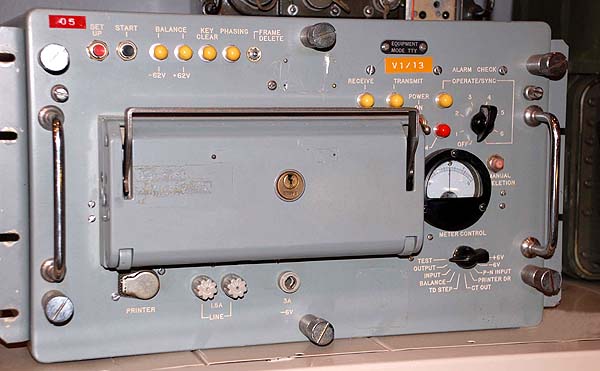 |
| This KG-14 example is held in the Communications and Electronics Museum in Kingston, Ontario. (Photo by Jerry Proc) |
The KG-14 was a stand alone crypto transmitter/receiver. On land line links, two were used at each end - one dedicated to receive, the other to transmit. A transmit KG-14 used one particular key card and the receive KG-14 used a different card. That made it hard for unauthorized users to figure out the entire path, should one side be compromised.This machine was also used in conjunction with the KW 37 system to provide
a multi-channel broadcast. The '14 could be configured as a transmitter or receiver. The transmit function just required additional electronic cards that the ships using the 14 as a receiver did not have. Basically, the TSEC/KWR-37 (see separate section) was brought into sync, then the KG-14's were started and synched automatically. For the most part, other than an alarm check, there was no operator intervention for synchronization like that which could be required for the KWR-37. Additionally, the KG-14 was a fine piece of electronic equipment, it rarely, if ever failed
 |
| This KG-14 example is held in the Communications and Electronics Museum in Kingston, Ontario. (Photo by Jerry Proc) |
 |
| KG-14 with card door open. Note the missing pin which provides clearance for the corresponding screw on the contact backplate. (Photo by Jerry Proc) |
Jerry Myers relates this KG-14 maintenance story. "While I was stationed at RM "A" School at NTC (now closed) in San Diego, I was in charge of the equipment of the Prac Deck. I had an intermittent problem in one of the TSEC/KG-14's that was being used as a transmitter. It would go into alarm about once a week. I finally "shotgunned" half the boards from the repair kits to isolate the problem down to a board. When I found the intermittent board, I sent it down to CRF (Crypto Repair Facilities) and let them fix it. They didn't find anything and told me if it worked for 24 hours they were done with it. I then shotgunned the other half the "flyball" modules and isolated it to the faulty module. It took some time as it only went into alarm once a week. I finally found the bad module and started peeling the cover off and cutting into the potting to see what I could find. I never did find what was wrong but did find transistors marked 2N404 in them. I know, what a waste of time but I was curious and did not let a problem like this beat me.In a room next to the Prac Deck we had two DSTE's running back to back with no Crypto between them. There was also there was a bunch of high speed Teletype's that would light off, then wind up and spit out punched tape for quite a ways. These teletypes were used for training the Radioman to handle messages. The DSTE's had an intermittent problem in one or both that we never found. The Radioman were using the DSTE's to print up school and class rosters by punching a card (limit 80 characters) with the student's name and limited information, then manually sort them into classes. They ran the cards through the machine as many times as the instructors needed a copy. There was one student's name that would alarm every time it was sent through. It was the only name I ever saw do this, some kind of combination of letters and numbers I assume. This is one problem that beat us. Has anyone encountered such a problem? Contact Jerry Myers <jerry1joan(at)aol.com>
As a result of the capture of the USS Pueblo in 1968 by the North Koreans, the following cryptographic systems were compromised: KL-47, KW-7, KWR-37 and KG-14. An NSA report dated July 1969, details the cryptographic losses. A copy of this report can be found here.
Credits and Contributors1) Jerry Myers <jerry1joan(at)aol.com>
2) Communications and Electronics Museum, Kingston Ontario.
3) Curtis Law, Kodiak Military History Museum
Sept 22/08